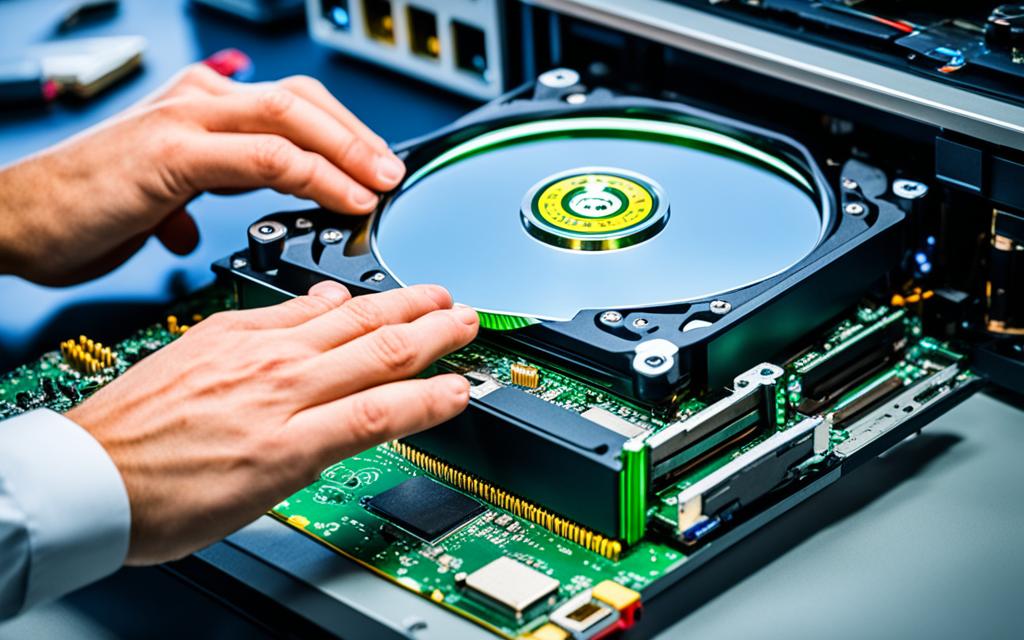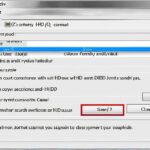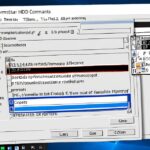Table of Contents
Optimising your hard drive is key, and formatting it to NTFS is vital. This process ensures compatibility and performance, especially in Windows. The New Technology File System, or NTFS, started in 1993 by Microsoft. It’s the main file system for the Windows NT family1. With NTFS, you get to handle large files and volumes. Plus, it offers better security than older systems like FAT321.
Knowing how to format your hard drive is essential. It helps keep your system running well and protects your data. Next, we’ll explore why formatting matters, the differences between drives, and how to do it right.
Key Takeaways
- NTFS is superior for performance, supporting larger files and enhanced security features.
- Migrating to NTFS formatting can increase efficiency in file management.
- Understanding the right file system for your needs is critical for optimal functionality.
- Formatting can safeguard your the data and streamline access speeds.
- AOMEI Partition Assistant is a recommended tool for formatting and conversion between file systems.
Understanding NTFS Format
Learning about the NTFS format is key for Windows users. Launched by Microsoft in 1993, NTFS has become essential for Windows NT, thanks to its durability and modern data handling capabilities. It supports large files, perfect for today’s media-heavy content2. NTFS can handle files up to 16 exbibytes minus 1 kilobyte. This is much more than the FAT32 system, which can’t manage files over 4 GB2.
What is NTFS?
NTFS uses a b-tree directory to handle big files and directories efficiently. Depending on the drive size, clusters can vary from 512 bytes to 64 KB3. This setup helps with quick and reliable file sorting and access.
Advantages of NTFS over Other File Systems
NTFS brings several benefits, especially in file size management. Its security features, like access control and encryption, protect data. This makes NTFS great for personal and work use3. It also has disk quotas for managing storage and allows file compression for faster transfers3.
Even though NTFS works best with Windows, it has read-only limits on non-Windows systems. But, it’s more flexible than FAT32, even with Mac OS X which can only read NTFS3. Compared to exFAT, NTFS is better for external drives with its support for up to 16 exabytes2.
| File System | Max File Size | Max Volume Size | Security Features | Compatibility |
|---|---|---|---|---|
| NTFS | 16 exbibytes | 8 petabytes | Access control, encryption, journaling | Best with Windows, limited with others |
| FAT32 | 4 GB | 8 TB | Basic file permissions | Widely compatible |
| exFAT | 16 exabytes | 128 PB | Basic security features | Supports various devices, ideal for flash drives |
Importance of Formatting HDDs
Formatting hard drives is key to keeping them working well and lasting long. It’s something users must know to ensure their computers run without problems. Formatting gets your drive ready for use, free from old files and mistakes. It’s especially needed when you’re setting up a new operating system or switching file systems. Doing it right can make your computer much nicer to use.
Why Format Your Hard Drive?
Formatting wipes all data from the hard drive. It’s like giving it a brand-new start for managing files better. For those thinking about why we need to format, remember, since Windows 2000, operating systems use NTFS. This gives us benefits like journaling and encryption to keep our data safe4. Not formatting can lead to slow performance and even lost data, especially if the hard drive isn’t in good shape.
Differences Between Primary and Secondary Drives
It’s important to know the difference between primary and secondary drives. The primary drive holds the operating system and must be formatted carefully for the best performance. Secondary drives are mainly for storing extra data and might not need as detailed formatting. Yet, formatting them properly can speed up access to data and makes transferring files quicker. This is true for SSDs, which are faster and more reliable than old HDDs [SSDs provide unmatched benefits]. Keep in mind, SSDs have a limit on how many times they can be written to. So, correct formatting is crucial to keep them working well5.
How to Choose the Right File System
Choosing the right file system is key for your data storage. NTFS, FAT32, and exFAT are the top choices, each with its benefits6. They are suited for different uses.
Understanding NTFS, FAT32, and exFAT is vital. NTFS is great for internal drives, supporting files up to 8 petabytes. It’s ideal for Windows and backing up data because it is long-lasting and can be recovered7. With the help of drivers, it can work on Macs too6. FAT32 works with many systems but has a 4GB file size limit, making it less useful today7.
exFAT is a versatile option, allowing files up to 128 petabytes. It works well with Windows and macOS, perfect for sharing files between them8. Each system serves specific needs, so knowing what you need is key for productivity.
Considerations for External Drives vs Internal Drives
For external drives, NTFS is great for security. It supports BitLocker encryption6. It’s reliable for backups7, making it a safe choice for your data.
exFAT is the choice for drives used across different platforms6. It has good read/write abilities. For internal drives, where it matters most, NTFS is the best. Knowing these points helps pick the right file system for you.
How to Format HDD to NTFS
Formatting a hard drive may seem hard, but it’s important if you want to make the most of your storage. Follow NTFS formatting instructions carefully to handle your data well. Begin by finding the drive you want to format using Windows Disk Management, a handy tool for guide to HDD formatting.
If you’re formatting your main drive, like the C: drive, use a Windows DVD or USB. That’s because you can’t format it while the operating system is running. This method changes the file system to NTFS, which works well with newer Windows systems and keeps files secure. Before you start, make sure to back up your data, as formatting wipes everything2.
Formatting other drives, whether they’re inside or outside the computer, is quite similar. You can pick a quick format for speed or a full format for a thorough clean2. If you worry about losing data, tools like MiniTool Partition Wizard Free can switch from FAT to NTFS safely9.
Look at a detailed guide to HDD formatting for easy steps. After choosing the file system and confirming, start formatting. Soon, your HDD will be ready for all your storage needs, from simple files to big applications.
p>
| Drive Type | Formatting Process | Time Required | Data Loss Risk |
|---|---|---|---|
| Primary Drive (C:) | Boot from Installation Media | Varies (Hours) | High (Backup Necessary) |
| Internal Drive | Disk Management Tool | Quick (Minutes) / Full (Hours) | High (Backup Necessary) |
| External Drive | File Explorer / Disk Management | Quick (Minutes) / Full (Hours) | Medium (Use of Data Recovery Software Advisable) |
Methods to Format an HDD to NTFS on Windows
Formatting a hard drive to NTFS on Windows can be done in several ways. You can use the Disk Management tool, find help in File Explorer, or command through Diskpart. Each has its benefits depending on what you know and need. It’s key to choose the right method to keep your data safe, as formatting might erase it10.
Using Disk Management
Disk Management is easy for formatting drives. Right-click ‘This PC’ and hit ‘Manage’. Then, go to ‘Disk Management’, right-click the drive to format, and click ‘Format…’. Choose NTFS, confirm, and you’re set for a tidy storage space11.
Formatting via File Explorer
File Explorer offers a simpler way to format. Right-click the drive you want to format and pick ‘Format’. Select NTFS as the file system. This six-step route is user-friendly, perfect for anyone to follow10.
Employing the Diskpart Command Line
If you’re good with commands, Diskpart is great. Find it by typing ‘cmd’ in search, then ‘diskpart’ at the prompt. Use commands to choose and format your disk. This suits those wanting precise control over the process12.
Choosing the right method makes formatting your HDD to NTFS easy. Remember to look into data recovery options to safeguard against accidental loss. For detailed steps on formatting, visit this useful resource.
FAQ
What is the purpose of formatting a hard drive to NTFS?
When you format a hard drive to NTFS, you boost its performance. It gets compatible with newer Windows settings. It also helps in improving security and filing system.
Can I format a primary drive while the operating system is active?
No, formatting a primary drive with the operating system on it isn’t possible. You must boot your PC from Windows installation media or a recovery disk. This way, a different setting is used for formatting.
What are the key differences between NTFS, FAT32, and exFAT?
NTFS is good for big files and gives you better security, perfect for internal use. FAT32 works with many devices but can’t take files over 4GB. ExFAT can handle big files too but without NTFS’s security.
Are there any risks associated with formatting a hard drive?
Yes, when you format a drive, all data is wiped permanently. Make sure to back up important stuff first. This ensures you don’t lose any crucial files.
How can I select the appropriate file system for my needs?
Think about how you’ll use the drive, what devices it needs to work with, and your security needs. NTFS is great for big files and security. ExFAT is good for using with various devices. FAT32 is best for smaller files where device compatibility matters most.
What are the steps to format an HDD to NTFS using Disk Management?
To format an HDD to NTFS, first right-click ‘My Computer’ and choose ‘Manage’. Then go to ‘Disk Management’. Right-click the drive you want to format, click ‘Format…’, pick NTFS, and then follow the instructions to finish.
Source Links
- https://www.diskpart.com/articles/format-external-hard-drive-to-ntfs-7201.html – 4 Ways to Format External Hard Drive to NTFS in Windows 11/10/8/7
- https://www.avg.com/en/signal/how-to-format-hard-drive – Ultimate Guide: How to Format a Hard Drive
- https://www.techtarget.com/searchwindowsserver/definition/NTFS – What Is NTFS And How Does It Work?
- https://www.securedatarecovery.com/blog/formatting-hard-drive-for-windows – Formatting Your Hard Drive for Windows
- https://www.sweetwater.com/sweetcare/articles/hard-drive-file-systems-and-why-they-matter/ – Hard Drive File Systems and Why They Matter – SweetCare
- https://www.twit.community/t/ntfs-vs-exfat-which-format-to-choose-for-external-hard-drive/14340 – NTFS vs exFAT which format to choose for external hard drive
- https://www.pcmag.com/how-to/fat32-vs-exfat-vs-ntfs-which-format-is-best-for-your-storage-drive – FAT32 vs. ExFAT vs. NTFS: Which Format Is Best for Your Storage Drive?
- https://www.nytimes.com/wirecutter/blog/how-to-format-your-external-hard-drive/ – How to Format Your External Hard Drive
- https://www.partitionwizard.com/partitionmanager/format-usb-to-ntfs.html – How to Format USB Drives to NTFS in Windows 10/8/7
- https://www.easeus.com/partition-master/format-external-hard-drive-to-ntfs.html – How to Format External Hard Drive to NTFS (No Data Loss)
- https://www.doyourdata.com/erase-data/format-external-hard-drive-on-windows-11.html – 2024 Top 4 Methods to Format External Hard Drive on Windows 11
- https://www.doyourdata.com/mac-solution/can-not-format-hard-drive-to-ntfs-on-mac.html – (Solved) Can Not Format A Hard Drive or USB Drive to NTFS on Mac








